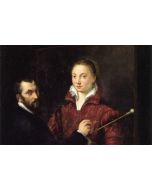Origins of the Italian Renaissance: The Primitivi
This course will be delivered online. See the ‘What is the course about?’ section in course details for more information.
This course has now started
- Course Code: VB935
- Dates: 19/04/24 - 24/05/24
- Time: 10:30 - 12:30
- Taught: Fri, Daytime
- Duration: 6 sessions (over 6 weeks)
- Location: Online
- Tutor: Simone Chisena
Course Code: VB935
Duration: 6 sessions (over 6 weeks)
Please note: We offer a wide variety of financial support to make courses affordable. Just visit our online Help Centre for more information on a range of topics including fees, online learning and FAQs.
What is the course about?
The 13th century sees the rapid evolution of the seeds sown in the previous century with the accession to the throne of France of Philip II Augustus (1180) and the death of Frederick Barbarossa (1190): the old feudal order starts to give way to the emerging, rampant middle classes (merchants and bankers) and, with them, romance languages start to form; the universities of Bologna, Paris and the latter’s English daughters Oxford and Cambridge are training the first generation of the thought professionals we will come to know as the “intellectuals”; the Paris alumnus Lotharius of Segni, elected pope as Innocentius III, sets out to reform the Church with the help of two great saints, Dominic Guzman from Spain and Francis from Assisi founders of the Dominican and Franciscan orders, bound to become the most influential orders of their time.
In this historical climate two cities - Florence and Siena - wage a duel for the control of Tuscany, in a battle that will take place on the field as well as on the walls of churches and public palaces and that will translate the stiff, rigid Greek Byzantine art into the new, Western art of the emerging classes.
This course will look at the historical circumstances that lead to the clash of the two cities, moving them to investigate the life and work of the major artists of the respective schools and the circumstances that saw them work together to forge the new language of Western art.
This is a live online course. You will need:
- Internet connection. The classes work best with Chrome.
- A computer with microphone and camera is best (e.g. a PC/laptop/iMac/MacBook), or a tablet/iPad/smart phone/iPhone if you don't have a computer.
- Earphones/headphones/speakers.
We will contact you with joining instructions before your course starts.
What will we cover?
• The historical context, the rivalry for the control of Tuscany and the battle of Montaperti
• The Florentine School: Cimabue
• The Florentine School: Giotto
• The Basilica of Assisi: Florence and Siena at work together
• The School of Siena: Duccio da Buoninsegna
• The School of Siena: Simone Martini and the Lorenzetti brothers.
What will I achieve?
By the end of this course you should be able to...
• Understand the historical context of the late Middle Ages in Europe;
• Identify the major protagonists of the Italian artistic scene in the 13th and 14th centuries;
• Describe the subjects and techniques employed in the frescoes at the Assisi Basilica.
What level is the course and do I need any particular skills?
This course is suitable for all levels.
You should be able to follow simple written and verbal instructions, demonstrations, hand-outs and health and safety information, and use basic elements of Zoom, like the microphone and camera.
How will I be taught, and will there be any work outside the class?
You will be taught online with slide presentations and group discussions. Handouts will be provided by your tutor to support your learning on the course; these handouts will be available online/digitally for download via the college’s Google Classroom. You will be sent an invitation to join the Google Classroom within a week of the course start date.
Are there any other costs? Is there anything I need to bring?
You might wish to purchase a notebook for taking notes. You might wish to buy some of the books on any reading list provided.
When I've finished, what course can I do next?
The Rise and Fall of the Italian Renaissance
Reimagining the Renaissance.
Simone Chisena gained a BA in Classics (dissertation on Greek Vascular Painting) from the University of Pavia and an MSc in Archaeology (dissertation on anthropomorphic menhirs from the Alps) from the University of Rome "La Sapienza". After moving to the UK, his research has focused on prehistoric art of the Upper Palaeolithic (35k-10k years ago), on which he is completing his PhD at the University of York. Alongside teaching for the University of York's Department of Archaeology, he has taught courses on prehistoric art at the Centre for Lifelong Learning and, since 2022, at CityLit. A natural eclectic, his current research focuses on the transmission of artistic skills in European prehistory, but he has not forgotten his Classics background and has never stopped cultivating his interests in Ancient Greek and Roman art.
Please note: We reserve the right to change our tutors from those advertised. This happens rarely, but if it does, we are unable to refund fees due to this. Our tutors may have different teaching styles; however we guarantee a consistent quality of teaching in all our courses.
